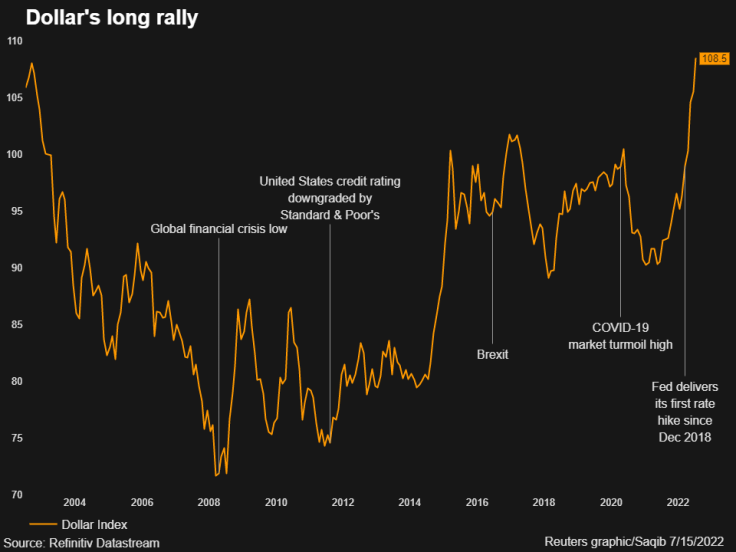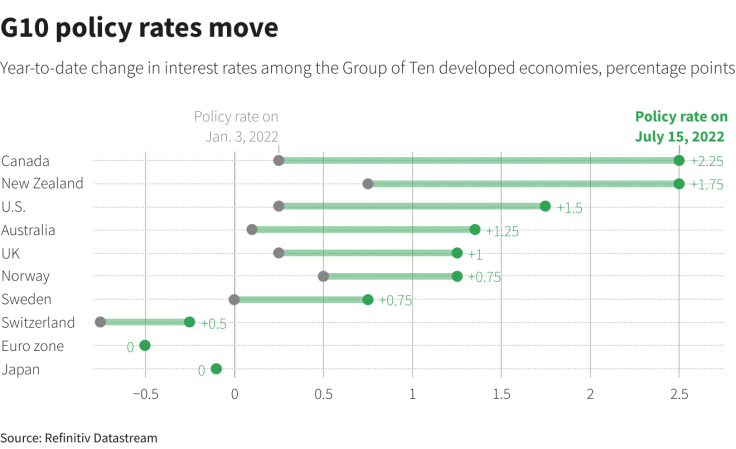Analysis-As Dollar Roars Higher, Few Dare To Stand In Its Way
An epic rally in the dollar has investors wondering how much further it can run, though many are biding their time before turning bearish on the U.S. currency.
The dollar is up about 13% this year to a two-decade high against a basket of peers and is on pace for its best year since 1997, lifted by a hawkish Federal Reserve and investors seeking a haven from global economic uncertainty.
Its steady climb has rippled through markets, helping push the euro to its lowest level in more than two decades and weighing on the earnings of U.S. corporations such as Microsoft and BlackRock.
Graphic: Dollar rally-

The extent of the dollar's strength has taken markets by surprise.
A model used by BoFA Global Research comparing macroeconomic fundamentals in different economies, for example, last month showed the dollar was overvalued against the currency of every G10 country. Moreover, history shows that while the greenback tends to strengthen before a Fed hiking cycle, it begins to fall soon after, a pattern it has so far deviated from.
Still, the dollar's momentum has made investors hesitant to stand in its way.
"Almost any currency looks attractive compared to the dollar on a longer-term basis, but investors have to ask themselves ... what happens if you put on a position and the dollar keeps on strengthening?" said Brian Rose, senior economist at UBS Global Wealth Management.
Though recession worries have flared in the U.S. as the Fed tightens monetary policy, the outlook for many other economies appears even gloomier, increasing the dollar's allure. A potential energy crunch in the euro zone, for example, has investors doubting the European Central Bank can raise rates far without hurting growth.
"One cannot have a weak USD (dollar) without a strong EUR (euro), and right now, the latter is in the midst of a structural shift that will be incredibly painful," analysts at TD Securities wrote. They believe the euro could fall as low as $0.85, after breaching $1.00 this week for the first time in 20 years.
Meanwhile, the Fed has raised interest rates faster than expected in an effort to tame inflation, putting yields in the U.S. higher than those in many developed countries. Higher rates make the dollar more attractive to investors.
Graphic: G10 policy rates move-

That gap may narrow as other central banks accelerate their own monetary policy tightening. The Bank of Canada raised rates by 100 basis points on Wednesday -- though this week's blistering U.S. inflation reading has bolstered expectations for a similar move from the Fed.
At the same time, positioning in rate futures markets shows investors expect policymakers to raise rates swiftly this year before easing in early 2023, as growth slows.
"The moment the U.S. economy runs into some kind of growth problem, the U.S. dollar is going to turn," said Thanos Bardas, senior portfolio manager at Neuberger Berman, who has reduced his dollar bets but remains bullish on the currency.
The median forecast in a Reuters poll earlier this month showed analysts expect the dollar to fall 8% against the euro over the next year. Most also see it strengthening in the next three months, however.
"If you close your eyes for 12 months, the dollar will probably have depreciated by the time you open them, but there will likely be significant volatility in the meantime," said Francesca Fornasari, head of currency solutions at Insight Investment, a UK-based asset manager, with about 817.1 billion pounds ($968.51 billion) in assets under management as of March 31.
Investor positioning shows the dollar likely has room to run, Fornasari said. Net bullish futures bets on the dollar stood at $18.20 billion in the latest week, compared with a $35 billion peak in 2019, data from the Commodity Futures Trading Commission showed.
Dollar bears are not completely extinct.
Jack McIntyre, portfolio manager at Brandywine Global, is underweight the dollar, betting that the near-20% drop U.S. stocks have experienced this year will weigh on the economy and increase the likelihood of the Fed ending its tightening cycle earlier.
"As equities continue to weaken, that is a big tightening of financial conditions. That is going to hurt the U.S. consumer," he said.
Others, however, believe little can stop the dollar from strengthening until there's evidence that the Fed's policy tightening is peaking.
"The USD remains king of FX and it will be incredibly brave and naive to assume otherwise," wrote TD's analysts.
($1 = 0.8437 pound)
© Copyright Thomson Reuters 2024. All rights reserved.




















